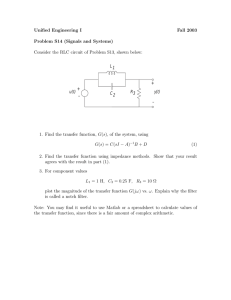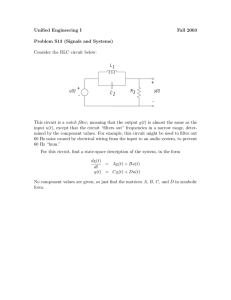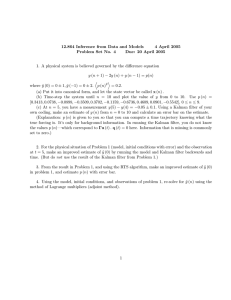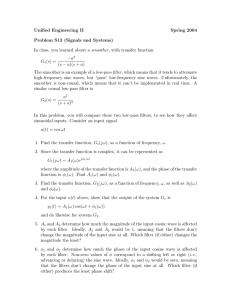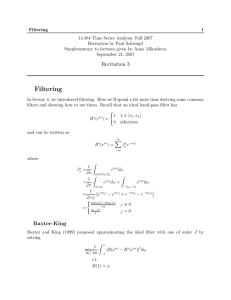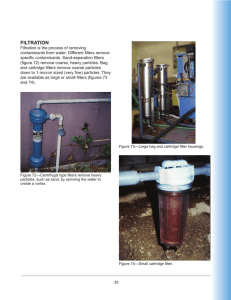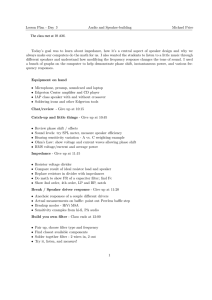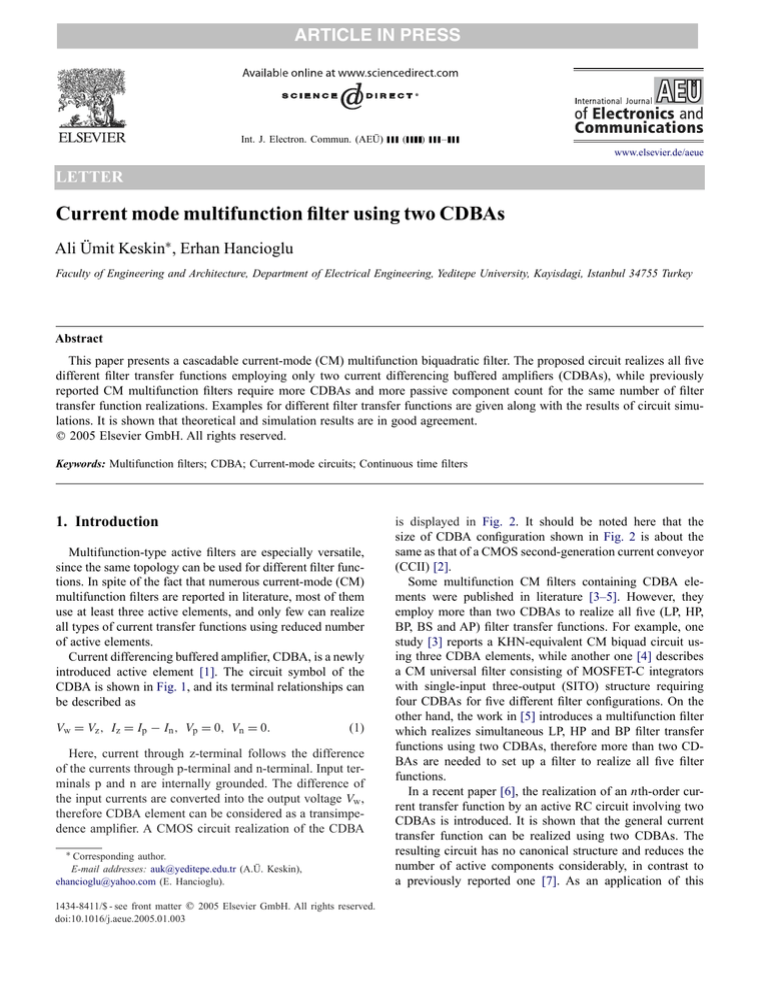
ARTICLE IN PRESS
Int. J. Electron. Commun. (AEÜ)
(
)
–
www.elsevier.de/aeue
LETTER
Current mode multifunction filter using two CDBAs
Ali Ümit Keskin∗ , Erhan Hancioglu
Faculty of Engineering and Architecture, Department of Electrical Engineering, Yeditepe University, Kayisdagi, Istanbul 34755 Turkey
Abstract
This paper presents a cascadable current-mode (CM) multifunction biquadratic filter. The proposed circuit realizes all five
different filter transfer functions employing only two current differencing buffered amplifiers (CDBAs), while previously
reported CM multifunction filters require more CDBAs and more passive component count for the same number of filter
transfer function realizations. Examples for different filter transfer functions are given along with the results of circuit simulations. It is shown that theoretical and simulation results are in good agreement.
䉷 2005 Elsevier GmbH. All rights reserved.
Keywords: Multifunction filters; CDBA; Current-mode circuits; Continuous time filters
1. Introduction
Multifunction-type active filters are especially versatile,
since the same topology can be used for different filter functions. In spite of the fact that numerous current-mode (CM)
multifunction filters are reported in literature, most of them
use at least three active elements, and only few can realize
all types of current transfer functions using reduced number
of active elements.
Current differencing buffered amplifier, CDBA, is a newly
introduced active element [1]. The circuit symbol of the
CDBA is shown in Fig. 1, and its terminal relationships can
be described as
Vw = Vz , Iz = Ip − In , Vp = 0, Vn = 0.
(1)
Here, current through z-terminal follows the difference
of the currents through p-terminal and n-terminal. Input terminals p and n are internally grounded. The difference of
the input currents are converted into the output voltage Vw ,
therefore CDBA element can be considered as a transimpedence amplifier. A CMOS circuit realization of the CDBA
∗ Corresponding author.
E-mail addresses: auk@yeditepe.edu.tr (A.Ü. Keskin),
ehancioglu@yahoo.com (E. Hancioglu).
1434-8411/$ - see front matter 䉷 2005 Elsevier GmbH. All rights reserved.
doi:10.1016/j.aeue.2005.01.003
is displayed in Fig. 2. It should be noted here that the
size of CDBA configuration shown in Fig. 2 is about the
same as that of a CMOS second-generation current conveyor
(CCII) [2].
Some multifunction CM filters containing CDBA elements were published in literature [3–5]. However, they
employ more than two CDBAs to realize all five (LP, HP,
BP, BS and AP) filter transfer functions. For example, one
study [3] reports a KHN-equivalent CM biquad circuit using three CDBA elements, while another one [4] describes
a CM universal filter consisting of MOSFET-C integrators
with single-input three-output (SITO) structure requiring
four CDBAs for five different filter configurations. On the
other hand, the work in [5] introduces a multifunction filter
which realizes simultaneous LP, HP and BP filter transfer
functions using two CDBAs, therefore more than two CDBAs are needed to set up a filter to realize all five filter
functions.
In a recent paper [6], the realization of an nth-order current transfer function by an active RC circuit involving two
CDBAs is introduced. It is shown that the general current
transfer function can be realized using two CDBAs. The
resulting circuit has no canonical structure and reduces the
number of active components considerably, in contrast to
a previously reported one [7]. As an application of this
ARTICLE IN PRESS
2
A.Ü. Keskin, E. Hancioglu / Int. J. Electron. Commun. (AEÜ)
Ip
(
)
–
Iw
Vp +
p
w
Vn +
n
z
p
+ Vw
CDBA
n
z
Yb
CDBA
Iz
w
n
w
p
+ Vz
in
Ya
Yc
lo
z
Yd
Iin
Fig. 1. Symbol for the CDBA.
Fig. 3. CDBA-based circuit realizing nth-order current transfer
function.
Vdd
M8
IB1
M10
M17 M18
M19
Cc
M5
M1
M3
M2
M4
n p
M7
p1
w1
n1
CDBA
1
z1
w
z
M12
M9
M15
The current transfer function of the circuit in Fig. 3 using
two CDBA elements has the following form in the case that
the CDBAs are ideal.
I0 (s) Ya − Yb
,
=
Ii (s)
Yc − Y d
(2)
where Yi are positive real admittance functions of passive
two terminal elements. One of their terminals is either
grounded or internally grounded.
Based upon this configuration, Fig. 4 displays the proposed current mode, CDBA-based multifunction filter.
Note that the circuit is a LP filter if Pa1 , w1 terminals are
shorted together;
I0
Rd 1/(Rb Cb Rd Cd )
=
,
Iin
Ra
D(s)
1
1
1
+
−
Rb Cb Rd Cd Rc Cd
w2
p2
CDBA
2
z2
Ca
Iout
Pa1
Cd
Fig. 4. CDBA-based current mode multifunction biquad.
It becomes a HP filter in the case that Pa2 and w1 terminals
are shorted together;
I0
Ca s 2
=
.
Iin
Cd D(s)
(5)
One will have a BP filter if Pa1 and Pa2 terminals are disconnected;
2. Proposed circuit
D(s) = s 2 +
n2
Ra
Rd
M16
general CM circuit that realizes an nth-order current transfer
function by an active RC circuit, the study here presents a
new current mode multifunction biquad which realizes all
five filter transfer functions using only two CDBA elements,
and reports the properties of this configuration.
where
Pa2
Iin
M20
Fig. 2. A CMOS realization of CDBA. In circuit simulations,
all bias currents and supply voltages are selected as 30 A and
+/ − 2.5 V, respectively.
H (s) =
Cb
M14
IB3
IB2
Vss
Rb
M11
M13
M6
Rc
(3)
s+
1
. (4)
Rb Cb Rd Cd
I0
s
1
.
=−
Iin
Rb Cd D(s)
(6)
When Pa1 , Pa2 , and w1 terminals are joined, a notch (BS)
filter is obtained if Ra = Rd = 2 · Rb , Cb = 2 · Cd = 2 · Ca .
s 2 + (1/(Rb Cb ))2
I0
=
.
Iin
D(s)
(7)
The last configuration can be used as an AP filter if Rc = ∞,
Ra = Rd = 4 · Rb , Cb = 4 · Cd = 4 · Ca .
s 2 − (2/Rb Cb )s + (1/Rb Cb )2
I0
.
=
Iin
D(s)
(8)
Note that, Ca is omitted (Ca = 0) for the low-pass configuration, Ra is omitted (Ra = ∞) for the high-pass filter realization. On the other hand, both Ra and Ca are omitted for
the band-pass configuration, while Rc is omitted for the all
pass case. The natural angular frequency 0 and the pole
ARTICLE IN PRESS
A.Ü. Keskin, E. Hancioglu / Int. J. Electron. Commun. (AEÜ)
Q=
1
(Rb Rd Cb Cd )
1/2
)
–
3
Table 1. Transistor aspect ratios used in circuit simulations
Q-factor of this filter are
0 =
(
,
(9)
(Rb Rd Cb Cd )
.
Rb Cb + Rd Cd − (Rb Rd Cb /Rc )
1/2
(10)
It is apparent that Q can be controlled by varying Rc without
affecting 0 .
Transistor
W (m)/L(m)
M1–M10
M11, M12
M13, M14, M17, M18
M15, M16
M19
M20
150/1
4/2
5/1
100/1
20/1
200/1
3. Non-ideal case
In non-ideal case, the CDBA can be characterized by
(11)
where p , n and are current and voltage gains, respectively, and p = 1 − εp , n = 1 − εn , = 1 − εv . Here, εp ,
εn are current tracking errors and εv is the voltage tracking
error, absolute values of all last three terms being much less
than unit value. Note that, natural frequency of this biquad
is not influenced by tracking errors of the CDBA, and other
0 and Q-factor sensitivities are
Q
SRd
Rb Cb − Rd Cd + p Rd Rb Cb /Rc
=−
,
2[p Rd Rb Cb /Rc − (Rb Cb + Rd Cd )]
Q
SRb
Q
= SCb
= −
Q
Q
(12a,b)
Rd Cd − Rb Cb + p Rd Rb Cb /Rc
,
2[p Rd Rb Cb /Rc − (Rb Cb + Rd Cd )]
p Rd Rb Cb
.
p Rd Rb Cb − Rc (Rb Cb + Rd Cd )
-30
300Hz
(13a)
BP
HP
BS
LP
10KHz
Frequency
300 KHz
Fig. 5. Results of circuit simulations relating bode plots for five
different current transfer functions.
Q
= −SCd
Sp = S =
-20
Q
S0 = Sp0 = Sn0 = Sn = SCd = 0,
1
SRb0 = SRd0 = SCb0 = SCd0 = − ,
2
Q
-10
gain (dB)
Vp = Vn = 0, Iz = p Ip − n In , Vw = Vz ,
AP
-0
(13b)
results of circuit simulations for the following cases (Vdd =
−Vss = 2.5 V):
(13c)
Here, for filters with complex poles, Q-factor sensitivities
(13a–c) can be minimized by proper selection of component
values. On the other hand, for filters having real poles, the
feedback path between w–p terminals of the CDBA vanishes. This means that two components are reduced from
the configuration, further desensitizing the Q-factor of the
circuit against tracking errors.
4. Circuit simulations
The CM filter configurations presented in this study are
simulated using the CMOS-based CDBA circuit given in
Fig. 2. Here, 0.5 MIETEC real transistor model parameters
are implemented for all transistors in the circuit. Transistor
aspect ratios are indicated in Table 1 . Fig. 5 demonstrates the
1. Low-pass filter, Butterworth: Cb = Cc = 0.707 nF, Cd =
1.414 nF, Ra = Rb = Rc = Rd = 10 K ;
HLPF (s) =
I0 (s)
106
.
=
√
Iin (s) s 2 + 2 × 103 s + 106
(14)
2. High-pass filter, Butterworth: Ca = Cb = Cc = Cd = 1 nF,
Rb = Rc = 14 140 , Rd = 7070 ;
HHPF (s) =
I0 (s)
s2
.
=
√
Iin (s) s 2 + 2 × 103 s + 106
(15)
3. Band-pass filter, Butterworth: Cb = 1.414 nF, Cc = Cd =
0.707 nF, Rb = Rd = 10 K , Rc = 20 K ;
√
2 × 103 s
I0 (s)
=−
.
HBPF (s) =
√
Iin (s)
s 2 + 2 × 103 s + 106
(16)
ARTICLE IN PRESS
4
A.Ü. Keskin, E. Hancioglu / Int. J. Electron. Commun. (AEÜ)
4. Notch filter, Butterworth: Ca =Cc =Cd =0.707 nF, Cb =
2 · Cd , Ra = Rc = Rd = 14 140 , Rb = 7070 ;
HBSF (s) =
I0 (s)
s 2 + 106
.
=
√
Iin (s) s 2 + 2 × 103 s + 106
(17)
5. All pass filter: Ca = Cd = 0.2 nF, Cb = 0.8 nF, Ra = Rd =
50 K, Rb = 12.5 K ;
HAPF (s) =
I0 (s)
s 2 − 2 × 103 s + 106
.
= 2
Iin (s) s + 2 × 103 s + 106
(18)
All absolute 0 and Q-component sensitivities at these
above-given component values are less than or equal to
unity.
It is noted that the theoretical and simulation results are
in good agreement.
5. Conclusion
In this paper, a CM multifunction filter involving two
CDBAs is introduced. The proposed circuit has the following properties: (a) Its 0 has small passive sensitivities, and
it is insensitive to tracking errors of the CDBA. (b) Its Q
can be controlled by varying Rc without affecting 0 in a
limited range due to low-Q of the circuit. (c) The proposed
circuit permits low input impedance due to unconditionally
grounded input terminals of the CDBA, therefore eliminating the loading problem for the current mode signal
source. (d) This non-canonic filter can be cascaded without
input–output impedance matching requirements. Note that,
most cascadable filters permit cascadability due to their
high output impedances. But, most of them do not exhibit
low input impedance (except [8]). (e) It employs capacitors
that are grounded or virtually grounded, which is an important aspect regarding integrated circuit implementation.
(
)
–
(f) In addition to the fact that the proposed circuit employs
only two active elements in realizing all five filter transfer functions, the number of passive components required
is less than those of previously reported CDBA-based CM
multifunction filters [3–5] for the same number of transfer
function realizations. (g) This multifunction biquad configuration is a universal filter in the sense that it realizes LP, HP,
BP and BS filter transfer functions. These advantages offset the passive component matching requirement that can be
easily met by today’s sophisticated IC manufacturing techniques. Therefore, this proposed CM filter consisting of two
CDBA elements and fewer passive components is expected
to be useful in analog signal-processing applications.
References
[1] Acar C, Özoguz S. A versatile building block: current
differencing buffered amplifier suitable for analog signal
processing filters. Microelectron J 1999;30:157–60.
[2] Hassanein WS, Awad IA, Soliman AM. New wide band low
power CMOS current conveyors. Analog Integrated Circuits
Signal Process 2004;40(1):91–7.
[3] Toker A, Özoguz S, Acar C. Current-mode KHN-equivalent
biquad using CDBAs. Electron Lett 1999;35(20):1682–3.
[4] Özoguz S, Toker A, Acar C. Current-mode continuous-time
fully-integrated universal filter using CDBAs. Electron Lett
1999;35(2):97–8.
[5] Özcan S, Kuntman H, Çiçekoǧlu O. Cascadable current mode
multipurpose filters employing CDBA. AEÜ Int J Electron
Commun 2002;56(2):67–72.
[6] Acar C, Sedef H. Realization of nth-order current transfer
function using current-differencing buffered amplifiers. Int J
Electron 2003;90(4):277–83.
[7] Acar C, Özoguz S. nth-order transfer function synthesis using
current differencing buffered amplifier: signal-flow graph
approach. Microelectron J 2000;31:49–53.
[8] Soliman AM. Current mode universal filter. Electron Lett
1995;32:1420–621.

